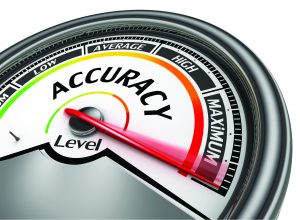Effective Estimating – Part 5 of 6
In the last Effective Estimating blog post, we talked about providing our prospective clients with multiple Estimates in an attempt to sell more projects. In this post we will look at our Estimate Accuracy.
In earlier posts in this Effective Estimating series, we talked about two principles of Effective Estimating. One being Managing Customer Expectations and we briefly touched on another, that your Estimates and Proposals should SELL MORE JOBS, but we have not touched on the first of these three principles, and in my opinion, one of the cornerstone principles of Effective Estimating.
Accuracy
I alluded to this principle when I said that your Estimates and Proposals should be bi-lingual in an earlier post, that they needed to speak two languages, Cost and Selling Price. The objective of a good Estimating System is to ACCURATELY account for the labor, material, overhead and profit, then AUTOMAGICALLY translate those costs into a selling price.
In my Effective Estimating Video Seminar, we will go through the 10 1/2 Attributes of Accuracy, but in this context, I just don’t have the bandwidth to go that deep into this subject matter. The primary point being, that if we abide by these 10 1/2 Attributes of Accuracy, we will have what I like to call a “full figured” Estimate (now you will know why I like to use the word sexy when speaking about Estimates and Proposals), which makes certain your client is comparing apples to apples, not apples to broccoli.
In all my years of being a cabinetmaker, and owning a custom cabinet manufacturing business, there have been two predominate estimating methods that I hear discussed often. The most popular (or at least it seems that way in the Southeast) is pricing cabinetry by the linear foot, the second being pricing cabinetry by the square footage of the face of the cabinetry. If I dig back deep enough into my pretty darn old memory banks, I even remember a formula where the cabinetmaker would add up all his material costs and multiply that by a factor (usually 3 back then, no telling what it is now).
Pretty much every cabinetmaker figures out fairly quickly that linear footage and square footage estimating methods are not only not accurate (1 ten foot cabinet with 3 drawer fronts, 3 drawer boxes, 3 drawer guides, 6 doors and 12 hinges costs the exact same amount as 10 one foot cabinets that have 10 drawer fronts, 10 drawer boxes, 10 drawer guides, 10 doors and 20 hinges using either method), and that these methods provide no way to translate material costs to selling price. If your hinges go up by $0.30 a pair, how much do you adjust your per linear footage or square footage price? If your sheet-goods go up by $0.10 a square foot, how much do you adjust your per linear footage or square footage price?
I am aware that lots of cabinetmakers have started doing add-ons, so much per door, so much per drawer front, etc., but this still does not translate from cost to selling price very well. Another attribute of these systems is they simply are not very accurate from one finish type or option to another, and the vast majority of pricing systems I have heard quoted simply used a percentage markup from one finish type or option to another finish type or option. How can we accurately express the difference in the cost from a natural finish on hickory to a complex stained, glazed, antiqued, distressed level three with wear sanding on cherry using a simple percentage markup? When customers sense that you are making numbers up, they lose confidence in your Estimating System and you, which is also a good reason not to round up or down. A round number Estimate looks like you are pulling your estimates out of thin air, and do not build confidence in your prospective customers.
Today we covered the Accuracy of our Estimates. In our next and final article in this Effective Estimating series, we will look at “The end depends upon the beginning.”
To make sure you won’t miss a crucial part of this discussion, enter your email address in the ‘Subscribe to Blog via Email’ field on the right, and each time one of us adds a blog post, you will automatically be notified. Oh, and you won’t hurt our feelings if, depending on where you are seeing this, you Share, Like, Plus or Re-tweet it (there are buttons somewhere on this page to help you with that).
May the Lord bless the work of your hands, heart and mind.
